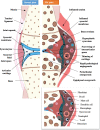Juvenile idiopathic arthritis: from aetiopathogenesis to therapeutic approaches
- PMID: 34425842
- PMCID: PMC8383464
- DOI: 10.1186/s12969-021-00629-8
Juvenile idiopathic arthritis: from aetiopathogenesis to therapeutic approaches
Abstract
Juvenile idiopathic arthritis (JIA) is the most common paediatric rheumatological disorder and is classified by subtype according to International League of Associations for Rheumatology criteria. Depending on the number of joints affected, presence of extra-articular manifestations, systemic symptoms, serology and genetic factors, JIA is divided into oligoarticular, polyarticular, systemic, psoriatic, enthesitis-related and undifferentiated arthritis. This review provides an overview of advances in understanding of JIA pathogenesis focusing on aetiology, histopathology, immunological changes associated with disease activity, and best treatment options. Greater understanding of JIA as a collective of complex inflammatory diseases is discussed within the context of therapeutic interventions, including traditional non-biologic and up-to-date biologic disease-modifying anti-rheumatic drugs. Whilst the advent of advanced therapeutics has improved clinical outcomes, a considerable number of patients remain unresponsive to treatment, emphasising the need for further understanding of disease progression and remission to support stratification of patients to treatment pathways.
Keywords: Aetiology of juvenile idiopathic arthritis; Disease-modifying anti-rheumatic drug treatment; Juvenile idiopathic arthritis; Pathogenesis of juvenile idiopathic arthritis.
© 2021. The Author(s).
Conflict of interest statement
The authors declare that they have no competing interests.
Figures

References
-
- Petty RE, Southwood TR, Manners P, Baum J, Glass DN, Goldenberg J, He X, Maldonado-Cocco J, Orozco-Alcala J, Prieur AM, Suarez-Almazor ME, Woo P, International League of Associations for Rheumatology International league of associations for rheumatology classification of juvenile idiopathic arthritis: second revision, Edmonton, 2001. J Rheumatol. 2004;31(2):390–392. - PubMed
Publication types
MeSH terms
Substances
Grants and funding
LinkOut - more resources
Full Text Sources
Medical

